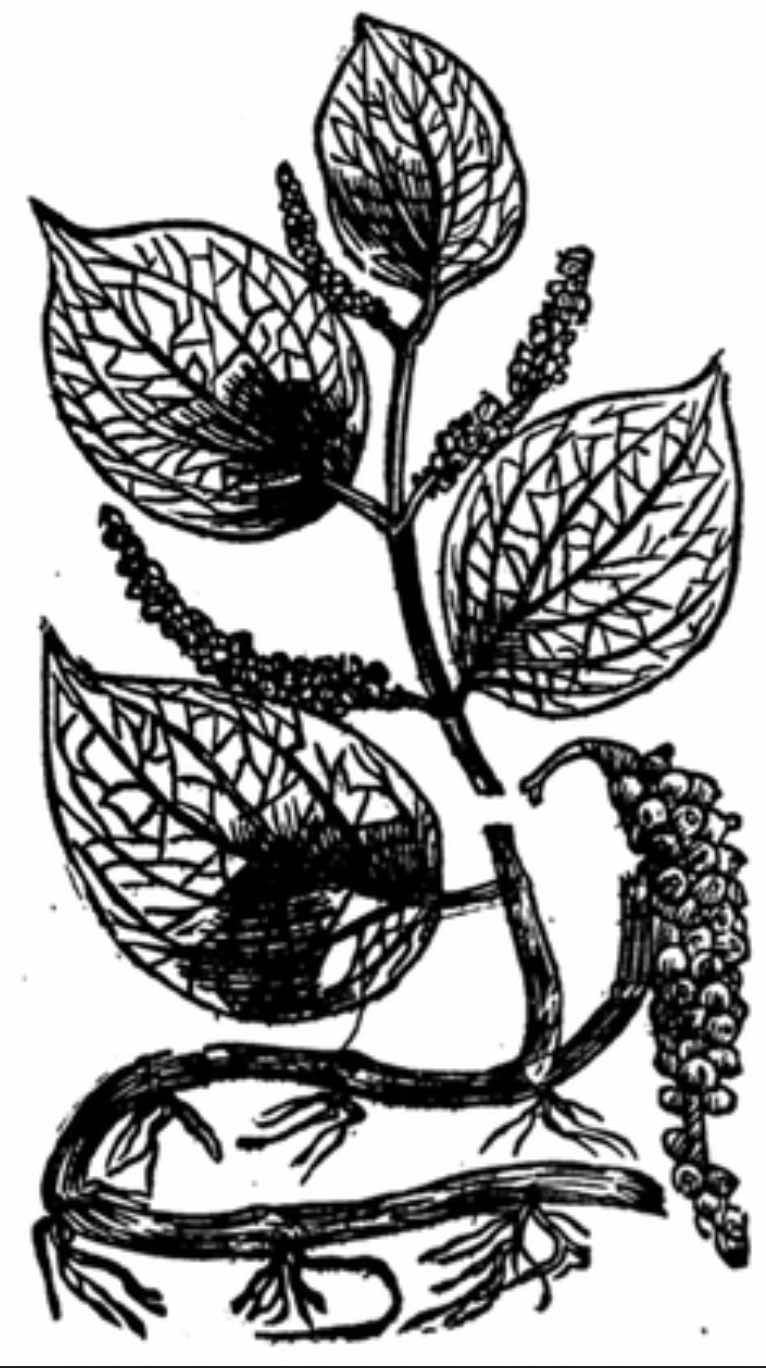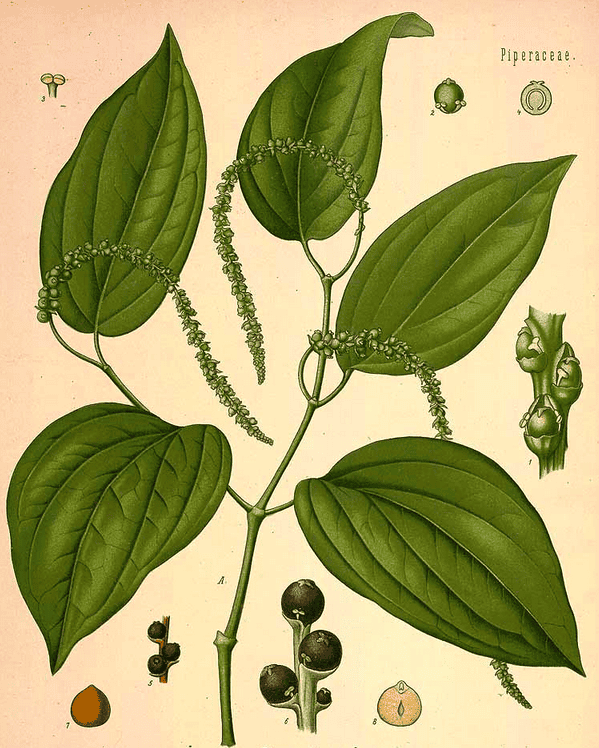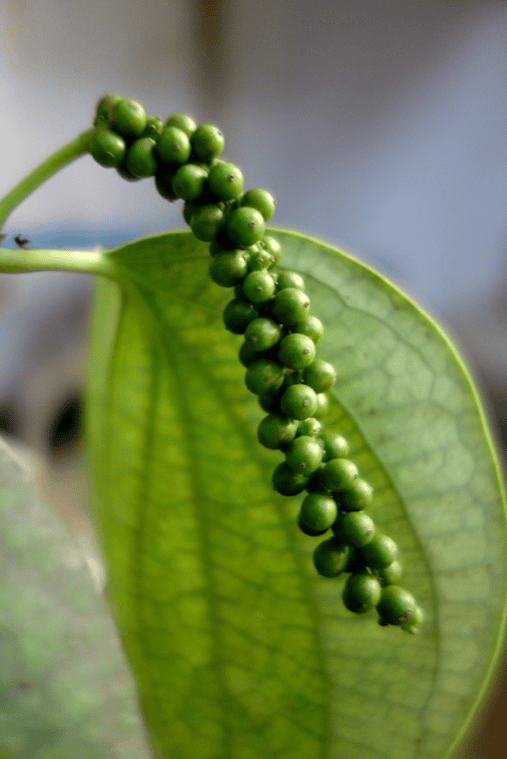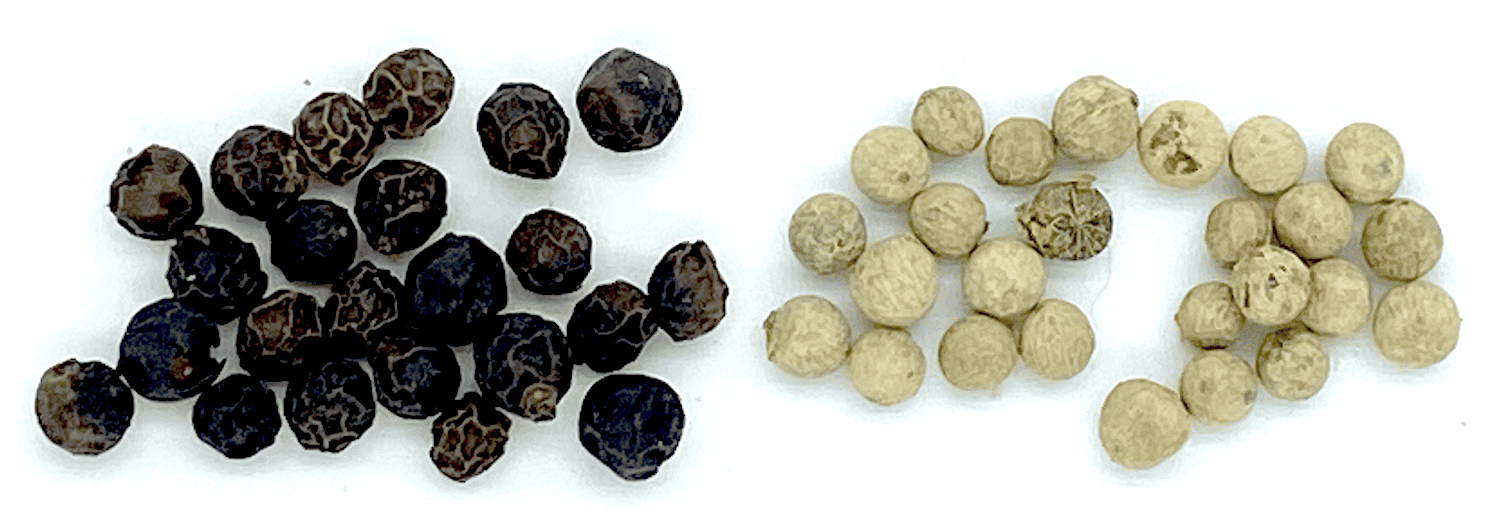Piper nigrum, Black Pepper, Hu Jiao 胡椒Marica (Ayurveda)Milaku (Siddha) Hu Jiao (TCM) Na le sham ན་ལེ་ཤམ (Tibetan) Filfil Siyah (Unani) Piper album, White Pepper, Bai Hu Jiao 白胡椒Bai Hu Jiao (TCM)Filfil Safaid (Unani) |

|
 Black Pepper, Parkinson, Theatrum Botanicum, 1640
Black Pepper, Parkinson, Theatrum Botanicum, 1640 Piper nigrum
Piper nigrumKoehler, Medizinal Pflanzen, vol. 2: 1890
 Green Piper fruits
Green Piper fruits(Calcutta Unani College, Adam, 2019)
 Black and White Pepper (Adam, 2022)
Black and White Pepper (Adam, 2022)Botanical name:
Piper spp.
P. nigrum: Black & White Pepper;
Parts used:
Fruit; Black Pepper is the fruit collected before fully ripe; White is fully ripe, the pericarp being removed before drying.
Temperature & Taste:
Hot, dry. Pungent
“Pepper is hot and dry up to the fourth degree … The White Pepper is weaker in warmth” (Avicenna)
Classifications:
2C INCIDERS. 2H. CARMINATIVE
3C. ALEXIPHARMIC. 3P. MASTICATORIES & STERNUTATORIES
4e. STOMACHIC
TCM:
M. Warm to Expel Cold
Uses:
1. Warms the Stomach, Clears Damp, Promotes Digestion (TCM, West, Ayurveda, Tibetan):
-abdominal pain, vomiting, diarrhea.
-Ayurveda uses Black Pepper for its anti-lipid activity, and for Obesity.
-Hyperacidity
-Black Pepper is important for clearing Ama in Ayurveda (toxic residue left from imperfect digestion; ‘Damp’ of TCM).
2. Clears Cold, Warms the Kidneys (TCM, West, Ayurveda, Tibetan):
-chronic Nephritis, Impotence
-Neurasthenia and Amnesia
3. Clears Cold Phlegm (TCM, West, Ayurveda, Tibetan):
-cold phlegm of the Lungs, Stomach, or Bowels
-Cold Cough (Black Pepper with Sugar Candy or Honey, Ayurveda)
4: Stops Wind, Eases Pain, Clears Cold and Damp:
-pacifies Vata/Wind in Ayurveda, and is said to help downward movement of Qi within the body;
-Headaches, Toothache, and Arthritis from Wind, Cold, and Damp;
-Sinusitis
-“gives intense warmth to the nerves and muscles and it is matchless in this action” (Avicenna)
5. Resists Poison:
-Common Cold, acute Sore Throat (Siddha)
-Food poisoning
-Poisoning from Mercury, Perchloride of Mercury, and Arsenic
-“White Pepper is incorporated in medicine used as antidotes”. (Avicenna)
6. Externally:
-topically, a paste of Black Pepper is massaged into the scalp to promote hair growth in Alopecia or baldness.
-Black Pepper is used as a gargle for acute Sore Throat.
Dose:
Powder: 250mg–1.5 grams
Decoction: 2–6 grams
Correctives:
Oil; Honey; Tragacanth
Substitutes:
1. White and Black Pepper can substitute one another
2. Ginger
3. Long Pepper
4. Cubeb
Comment:
1. Black, White and Long Pepper are used similarly. White Pepper is regarded as hottest but is least used. Black Pepper is better for the Stomach and Upper Body, while the Long Pepper is better for the Spleen and Kidneys and is regarded as more tonifying and strengthening. Clinically, either Black and Long Peppers, or all three Peppers, are often used together.
Main Combinations:
Trikatu (‘Three Pungents’)–Black Pepper, Long Pepper, Ginger
Trikatu is a mix of equal parts of Black Pepper, Long Pepper, and Ginger. It is both a stand-alone formula, and an important component of larger compounds. It warms the Stomach, increases Digestion, resolves Damp, Cold-Phlegm and Ama (toxic residue of undigested food). Used alone for Indigestion, Hyperacidity, Cold and Flu, Cough, Bronchitis and Asthma. It is regarded as useful in Obesity and Diabetes. It enhances bio-availability, meaning it increases effectiveness of other medicines it is combined with.
1. Warm the Stomach and Clear Cold-Phlegm:
i. Black Pepper, Conserve of Orange (equal parts), Syrup of Orange peel (sufficient to form an electuary). (Saunders)
ii. Black Pepper, Calamus, Galangal, Orange peel (Pharmacopoeia medici practici universalis, Bruxelles, 1817)
iii. Cold Phlegm of the Stomach, the Three Peppers are combined with Thyme, Annis and Ginger. (This is Trikatu with Thyme and Annis) (as in Powder of Three Peppers (Diatrion Piperion))
iv. Poor appetite and digestion, Long and Black Pepper, Ginger, Celery seed, Cumin, Asafetida, Rock Salt (as in Hingvastaka Churna)
2. Obesity:
i. Black Pepper with Betel leaf (Ayurveda)
ii. Black Pepper with Sodium nitrate. (Avicenna)
iii. Black Pepper, Fennel seed, Cyperus rotundus
3. Cold-type Cough and Asthma:
i. Black Pepper is used with Licorice, Elecampane
ii. Black Pepper, Coltsfoot, Raisins
4. Wind-Cold, Black Pepper with Ginger, Hyssop, Siler, Elecampane (as in Antidote for Wind and Cold of Nicholas)
5. Cachexia, Black Pepper, Elecampane, Fennel root (Pharmacopoeia medici practici universalis, Bruxelles, 1817)
6. Impotence, and as an Aphrodisiac,
i. Black Pepper is taken with Almonds and Milk (Ayurveda)
ii. Black Pepper, Long Pepper, Clove, Nutmeg, Rocket seed
7. Memory impairment:
i. Black Pepper, Calamus, Frankincense
ii. Black Pepper, Frankincense, Cyperus rotundus, Saffron
8. Scrofula, applied with Pitch to dissolve Scrofula. (Avicenna)
Major Formulas
Powder of Three Peppers (Diatrion Piperion) (Mesue)
Pills of Black Pepper (Unani)
Antidotum Apollonii Laodicensis (Nicholas)
Antidote for Wind and Cold (Nicholas)
Electuary of Calamus (Diacorum) (Mesue)
Electuary of Sulphur (Unani)
Electuary for Gastric Pain
Triphera of the Saracens (Triphera Saracenica Magna)
Mental Happiness (Sems kyi bde skyid) (Tibetan Medicine)
Powder of Clove (Ayurveda)
Powder of Camphor (Ayurveda)
Cautions:
1. Not suitable for use in Heat conditions or Yin deficiency.
2. “Its post coital use spoils the semen… It desiccates and destroys the semen” (Avicenna)
Main Preparations used:
Species Diatrion pipereon, Strong Species, Distilled Oil of Pepper
- Extra Info
- History
- Research
|
‘Pepper is one of the spices earliest used by mankind, and although now a commodity of but small importance in comparison with sugar, coffee, and cotton, it was for many ages the staple article of trade between Europe and India. It would require infact a volume to give a full idea of the prominent importance of pepper during the middle ages. In the 4th century B.C., Theophrastus noticed the existence of two kinds of pepper, probably the Black Pepper and Long Pepper of modern times. Dioscorides stated pepper to be a production of India, and was acquainted with White Pepper. Pliny’s information on the same subject is curious; he tells us that in his time a pound of long pepper was worth 15, of white 7, and of black pepper 4 denarii; and expresses his astonishment that mankind should so highly esteem pepper, which was neither a sweet taste nor attractive appearance, or any desirable quality besides a certain pungency. In the Periplus of the Erythrean Sea, written about A.D. 64, it is stated that pepper is exported from Barake, the shipping place of Nelkunda, in which region, and there only, it grows in great quantity. These have been identified with places on the Malabar Coast between Mangalore and Calicut. Long pepper and Black pepper are among the Indian spices on which the Romans levied duty at Alexandria about A.D. 176. Cosmas Indicopleustes, a merchant, and in later life a monk, who wrote about A.D. 540, appears to have visited the Malabar Coast, or at all events had some information about the pepper-plant from an eye witness. It is he who furnishes the first particulars about it, stating that it is a climbing plant, sticking close to high trees like a vine. Its native country he calls Male. The Arabian authors of the middle ages, as Ibn Khurdadbah (circa a.d. 869-885), Edrisi in the middle of the 12th, and Ibn Batuta in the 14th century, furnished nearly similar accounts. Among Europeans who described the pepper plant with some exactness, one of the first was Benjamin of Tudela, who visited the Malabar Coast in A.D. 1106. Another was the Catalan friar, Jordanus, about 1330; he described the plant as something like ivy, climbing trees and forming fruit, like that of the wild vine. “This fruit,” he says, “is at first green, then, when it comes to maturity, black.” Nearly the same statements are repeated by Nicolo Conti, a Venetian, who at the beginning of the 15th century, spent twenty-five years in the East. He observed the plant in Sumatra, and also described it as resembling ivy. In Europe, pepper during the middle ages was the most esteemed and important of all spices, and the very symbol of the spice trade, to which Venice, Genoa, and the commercial cities of Central Europe were indebted for a large part of their wealth ; and its importance as a means of promoting commercial activity during the middle ages, and the civilizing intercourse of nation with nation, can scarcely be overrated. Tribute was levied in pepper, and donations were made of this spice, which was often used as a medium of exchange when money was scarce. |
During the siege of Rome by Alaric, king of the Goths, A.D. 408, the ransom demanded from the city included among other things 5000 pounds of gold, 30,000 pounds of silver, and 3000 pounds of pepper. After the conquest of Csesareain Palestine, A.D. 1101, by the Genoese, each of them received two pounds of pepper and 48 soldi for his part of the booty. Facts of this nature, of which a great number might be enumerated, sufficiently illustrate the part played by this spice in mediaeval times. The general prevalence during the middle ages of pepper-rents, which consisted in an obligation imposed upon a tenant to supply his lord with a certain quantity of pepper, generally a pound, at stated times, shows how acceptable was this favourite condiment, and how great the desire of the wealthier classes to secure a supply of it when the market was not always certain. The earliest reference to a trade in pepper in England that we have met with, is in the Statutes of Ethelred, A.D. 978-1016, where it is enacted that the Easterlings coming with their ships to Billingsgate should pay at Christmas and Easter for the privilege of trading with London, a small tribute of cloth, five pairs of gloves, ten pounds of pepper, and two barrels of vinegar. The merchants who trafficked in spices were called Piperarii,— in English Pepperers, in French Poivriers or Pebriers. As a fraternity or guild, they are mentioned as existing in London in the Reign of Henry I. (A.D. 1154-1189). They were subsequently incorporated as the Grocers’ Company, and had the oversight and control of the trade in spices, drugs, dye-stuffs, and even metals. The price of pepper during the middle ages was always exorbitantly high, for the rulers of Egypt extorted a large revenue from all those who were engaged in the trade in it and other spices. Thus in England between A.D. 1263 and 1399, it averaged Is. per lb., equivalent to about 8s.of our present money. It was however about 2s. per lb. (=16s.) between 1350 and 1360. In 1370 we find pepper in France valued 7 sous 6 deniers per lb. (= fr. 21. c. 30) :— in 1542 at a price equal to fr. 11 per lb. The high cost of this important condiment contributed to incite the Portuguese to seek for a sea-passage to India. It was some time after the discovery of this passage (A.D. 1498) that the price of pepper first experienced a considerable fall; while about the same period the cultivation of the plant was extended to the western islands of the Malay Archipelago. The trade in pepper continued to be a monopoly of the Crown of Portugal as late as the 18th century. The Venetians used every effort to retain the valued traffic in their own hands, but in vain; and it was a fact of general interest when on the 21st of January 1522 a Portuguese ship brought for the first time the spices of India direct to the city of Antwerp. Strange to say, they were received with great mistrust! Pepper was heavily taxed in England. In 1623 the imposts levied on it amounted to 5s per lb.; and even down to 1823 it was subject to a duty of 2s. 6d. per lb. (Pharmacographia, Fluckiger & Hanbury, 1879) |
